The Last OI's: 1949-1955
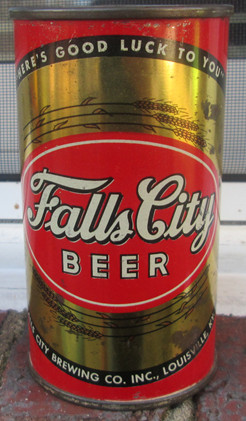 |
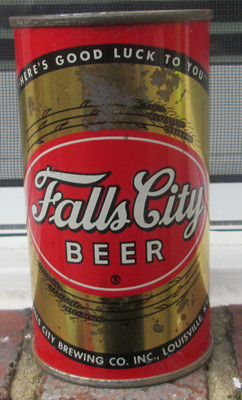 |
This month let’s look at some holdovers, the last Opening Instruction cans (OI's). In January 1935 the first beer cans went on sale in Richmond, Virginia. The Krueger Ale and Beers both had opening instructions on the sides, as did many of the early flat top cans. Not every early flat top had them. Coors never did. Neither did other early canned brands such as Storz. Some brands dropped them very early, such as Rheingold. By 1942, when cans for civilian use were no longer available, many brands had already dropped the OI panel. When beer cans returned for civilian use in 1947 a few brands still included the opening instructions, such as Budweiser. Other brands shrank the panel to take up less and less space as time went on. Most of these remaining hold outs dropped the panel in 1950 when the tax paid statement (IRTP) was dropped from the labels. Some brewers used this change to radically redesign their labels. Adam Scheidt brands Valley Forge and Rams Head Ale, for example, came out in very different labels, minus the OI, in 1950.
A few hold-outs though, kept the Opening Instructions even after they dropped the IRTP statement. These brands include Falls City, Genesee 12 Horse Ale, Hillman’s, Hornung’s Cream Ale, Hornung Bock, Hornung Beer, Krueger Bock, Neuweiler’s Cream Ale, Neuweiler’s Pilsner Beer, and Sterling Beer. That’s cans from seven breweries. Why did these brands hold onto the OI panel even after most of their competitors had stopped using it? There is no easily discoverable answer, but I can suggest a few reasons, at least for a few of them.
Some of the cans on this list made little or no design changes other than dropping the tax statement in 1950. There are a few exceptions. Neuweiler’s also dropped a New York license statement, but it was right above the tax statement, so that’s not a huge change. The Horning Ale comes in two variations with somewhat different shading and highlighting on the words “Cream” and “Ale. ” This may just be a result of printing different batches of cans and not a real redesign.
The two biggest standouts to me are the Krueger Bock and the Falls City. The Krueger not only dropped the IRTP statement, they redesigned the OI panel itself. They moved both instruction illustrations from one on each side of the seam, to both being on the same side. Moreover, they dropped the picture of the Canco churchkey. This was an especially odd decision because the Krueger Ale and Beer cans had dropped their OI panels before 1950.
The Falls City made less dramatic changes, but they did make some. The first non-IRTP OI dropped the tax statement and added a little trademark R to the front. They also added a statement on one back panel “THIS BEER IS UNION MADE.” A second version added the words “Premium Quality” to the front of the can. While not as big a change as the Krueger Bock, this still required a bit more work than just dropping the tax statement. The Opening Instruction panel remains the same despite other changes. Why go to so much trouble to make a change and yet keep the old OI panel?
Here they are in order: the last IRTP OI, the first non-IRTP OI and the second non-IRTP OI. Both of the non-IRTP OI's have a 1949 date code on the seam, so they were made in preparation for the end of the IRTP statement. That also seems to indicate that the first non-IRTP can was a short-lived label.
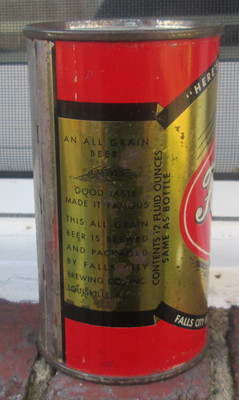 |
 |
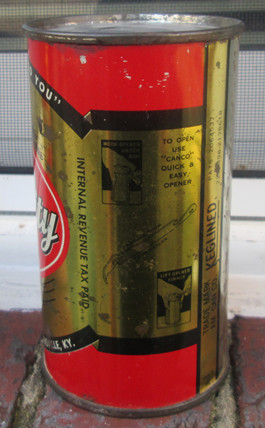 |
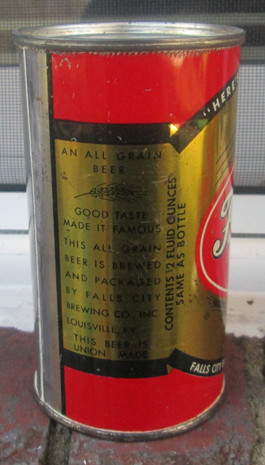 |
 |
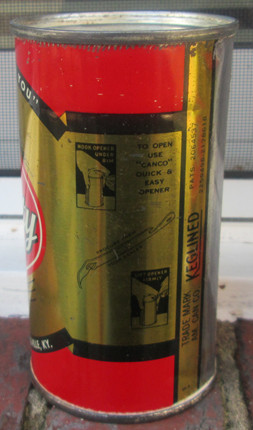 |
 |
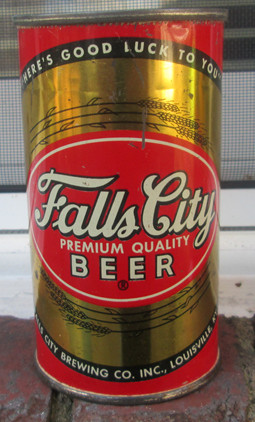 |
 |
I can think of a few possible reasons for keeping the OI panel. I have no evidence for any of them, so these are just some suggestions and nothing more.
To save money by making the redesign quicker and easier. This would save time paying a commercial artist. A quick erase and there you go.
To avoid confusing customers by keeping the design as familiar as possible. Just dropping a single statement on the back of the can wouldn’t be noticed by most consumers. I don’t this this one fits Krueger, who changed their beer and ale can designs an average of once a year between 1950 and 1960.
They felt some customers still needed the instructions. This one strikes me as unlikely. I might accept this rationale more with cans that came out in 1947 after the five-year rationing moratorium on civilian canning, but not in 1950.
Someone in brewery management liked the panels and wanted them to stay. Possible, but I have no evidence one way or another. Supposedly Coors kept the unpopular push-button top in the 1970s because one of the Coors family really liked it, so it’s possible.
They thought their customers were especially dim. OK, I’m just kidding with this one.
I suspect the first two reasons were the most likely. For whatever reason the Falls City, the Genny 12 Horse Ale, and the Sterling lasted the longest, to sometime in the mid-1950s. So the OI panel lasted a good twenty years from the first time a customer was faced with opening this new beverage container with a brand new tool.
